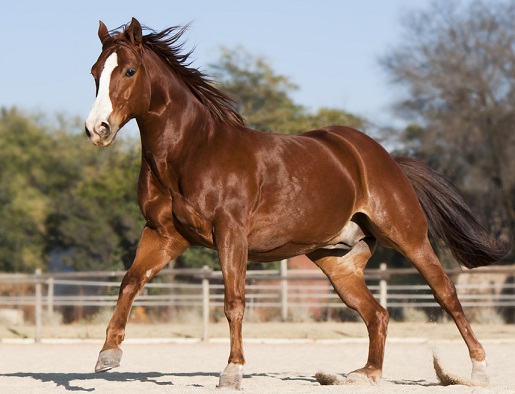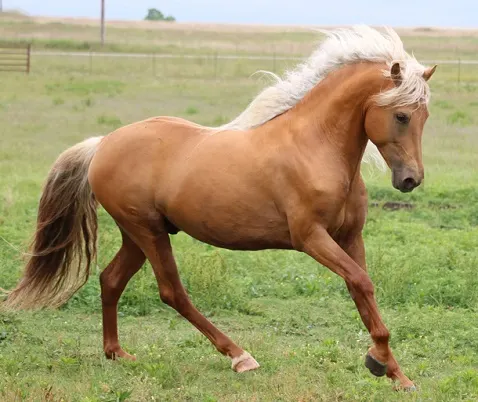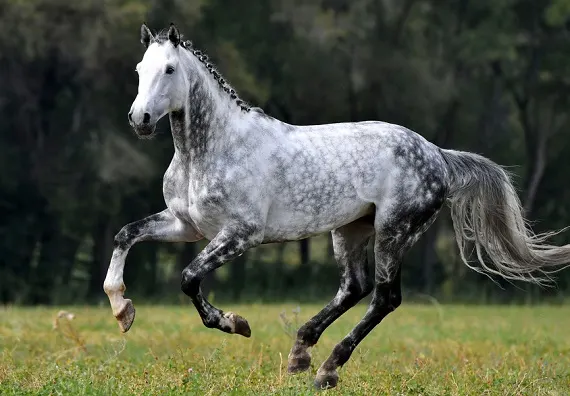Warmbloods dominate the world of equestrian sports due to their impressive athletic abilities, trainable brains, and compliant nature.
This middleweight horse type was developed from heavy draft horses by crossing these with light riding horses. As a result, they retained the strong bone and calm nature of coldbloods and the athleticism of hotbloods.
However, what is a warmblood horse exactly?
A warmblood horse is one of five types of horses that combines the traits of a coldblood and a hotblood horse. They are a versatile type of horse that dominates the highest levels of equestrian sports. Common Warmblood horse breeds are the Quarter Horse, Paint Horse, Mustang, Hanoverian, Oldenburg, Dutch Warmblood, Holsteiner, and Trakehner.
To clarify, the term “warmblood” has nothing to do with the horse’s body temperature. All horses have the same body temperature, regardless if they are warm, hot, or cold-blooded. These terms refer to the horse’s temperament only, and not their physiology.
Warmblood Horse Breeds

 Oldenburg Horse. Alexia Khruscheva / Shutterstock.com
Oldenburg Horse. Alexia Khruscheva / Shutterstock.com
Warmblood horse breeds are by far the most numerous and versatile out of all horse types. Many are bred for high-level equestrian sport and compete in international FEI and Olympic events.
Others are better suited for driving, western riding, or as all-around riding horses.
European Warmbloods
Most warmbloods bred for elite competition originate from continental Europe and carry the term in their names. These breeds include:
Hanoverian Oldenburg Dutch WarmbloodSelle FrançaisHolsteiner TrakehnerIrish Sport HorseWestphalianBelgian WarmbloodBavarian WarmbloodAmerican WarmbloodSwiss WarmbloodDanish WarmbloodSwedish Warmblood
Another way these breeds differ from other warmbloods is that they have an open studbook. This means that the parents of a registered horse don’t have to be purebred and can even come from a different breed. For this reason, many European warmbloods are not considered a “true” breed.
Instead of pedigree, open studbooks admit horses on a performance basis to keep improving the breed. If a horse meets the eligibility criteria, it may be registered regardless of its parentage.
There are, however, a few exceptions. Some European warmbloods have a less open studbook and are more distinctive than others. Examples are the Trakehner, Holsteiner, Hanoverian, and Selle Français breeds.
American Warmbloods

Quarter Horse. Jaco Wiid / Shutterstock.com
Outside the world of elite competition, many horse breeds classify as warmbloods. The United States, for example, has many popular horse breeds that fall in this category, such as:
Quarter HorsePaint HorseTennessee Walking Horse MorganStandardbredSaddlebredAppaloosaRocky Mountain HorseMustangColorado RangerMissouri Fox TrotterCurly Horse
All of these horse breeds come from a mix of hot and coldblood ancestry and are therefore considered warmbloods.
Although most have a specific purpose, these horse breeds are extremely versatile and can adapt to various activities.
Other countries also have their own warmblood breeds bred for various uses.
What is the difference between a warmblood horse and a Thoroughbred?
A warmblood horse is a result of crossing hotblood and coldblood horse breeds, while a Thoroughbred is a purely hot-blooded breed. Thoroughbreds are famously fast runners with a high-strung temperament, while warmbloods are talented sport horses with a quieter nature.
Thoroughbreds are one of the few hotblood breeds developed by humans, the others being the Arabian, Akhal-Teke, Barb Horse. They are famous for their role in horse racing and contributed to developing many warmblood breeds.
Is a Friesian a warmblood?
Although some people consider them coldbloods, Friesians are a warmblood breed. They might resemble coldbloods due to their robust appearance and strong bone, but Friesians are also elegant and agile for their size.

Friesian. otsphoto / Shutterstock.com
Like its Spanish relative, the Friesian horse descends from the destriers of the Middle Ages that carried armored knights. On the other hand, modern draft horses descend from heavy working animals used for agriculture and transport.
Due to their elegant appearance, high-stepping action, and energetic nature, Friesians are ideal for carriage driving, dressage, and marching on parades. They are also a popular breed to feature in historical and fantasy movies as they look great on camera.
The History of Warmblood Horses

Trakehner. Credit: Julia Remezova / Shutterstock.com
Warmbloods might not be as old as their hot-blooded counterparts, but they still have a fairly long history. Some experts believe they trace all the way back to the 13th century, while others date them to the Late Middle Ages.
One of the earliest warmblood breeds was the German Trakehner horse, developed in 18th-century Europe.
According to historians, the Trakehner emerged in East Prussia from the crosses of Thoroughbred, Arabian, and Schweiken horses.
A sought-after warhorse at the time, the Trakehner became the foundation for many modern warmblood breeds, such as the Hanoverian.
As the demand for an all-around riding, driving, and work horse increased, more warmbloods were developed to suit the needs of a changing society.
In the age of mechanization, the traditional roles of horses began to fade, and the public interest turned to sport and leisure. As a result, many heavy draft breeds were replaced by lighter and more athletic warmbloods better suited to riding.
Warmblood Horse Pros and Cons
Warmblood horses combine the best of both worlds, which is the main reason for their popularity. From coldbloods, they inherited good bone density, robust muscles, and even temperaments. Meanwhile, hotbloods gave them speed, endurance, agility, and a quick-thinking brain.
Size 
Morgan Horse. Lisa Kolbenschlag / Shutterstock.com
In terms of size, warmbloods are most suitable for adult riders. They average 14 to 16 hands (142 to 163 cm) at the withers, but many grow at tall as 17 hands (172 cm).
As for body mass, they fall in the middleweight category, ranging from 1,200 to 1,700 pounds (550 to 750 kg). As they are slightly heavier than hotbloods and ponies, warmbloods can get strong at times and require a confident rider to keep them under control.
Temperament
The temperament of a warmblood are in between that of a hotblood and a coldblood. They are not as reactive as a Thoroughbred or Arabian, but are more sensitive than a draft horse
In general, warmbloods are level-headed horses that won’t flee from every sudden noise or strange object on the roadside. At the same time, it takes patient training to make them reliable horses in every situation.
Abilities 
arthorse / Shutterstock.com
The greatest advantage of warmbloods lies in their versatile abilities that make them suitable for a range of uses.
From companion animals to speedy barrel racers and Olympic jumpers, warmbloods will stand their ground no matter their challenge.
With that being said, every warmblood breed has its own special talent. The popular Irish Sport horse, for example, is regarded as the star of the hunting field. These horses result from a direct cross between the Irish Draft and the Thoroughbred breed.
Generally, most European warmbloods excel in traditional English disciplines, such as show jumping, dressage, eventing, and carriage driving.
In contrast, many American and Australian warmblood are better suited to western riding and ranch work.
Are warmbloods good for beginners?
Well-trained warmbloods with an even temperament make good horses for beginners. Ideally, a beginners’ horse should have at least a few years’ experience working under saddle.
While many warmblood breeds are suitable for beginners, some are more reliable than others. Typical confidence-givers include the Haflinger, Fjord Horse, Icelandic Horse, Morgan, and Gypsy Vanner Horse.
At the same time, good beginner horses are found in every horse type. As long as the horse is patient, predictable, and experienced, it can safely be considered for novice riders.
What are warmbloods like to ride?
Warmbloods are typically big-moving horses with ground-covering strides that are very comfortable to ride. They have good rhythm and impulsion coming from the hind legs, and are generally responsive to the rider’s aids.

Rolf Dannenberg / Shutterstock.com
However, not all warmbloods are built the same. Smaller warmbloods like the Quarter Horse or Morgan have shorter, quicker strides and require a different riding approach.
Others like the Standardbred, Paso Fino, or Icelandic horse have special gaits unique to the breed. These were originally developed to give a smooth sensation to the rider who often spent long hours in the saddle.
How much does a warmblood horse cost?
An average warmblood horse costs between $2,000 to $10,000. As with any horse, the price of a warmblood varies greatly with age, breed, and training. A high-end or intermediate competition horse can cost up to $50,000.
It’s not uncommon to see young, untrained warmbloods with a questionable pedigree advertised for a few hundred dollars.
On the other end of the spectrum, there are the champion sport horses with excellent pedigrees and six-figure price tags.
Generally, the price of a horse reflects its potential in a given discipline and the work you have to put in to get there.
While many people are tempted to buy young and inexperienced animals, paying those extra dollars is often worth getting you closer to your goal.
Source: horseyhooves.com





